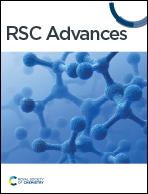Antioxidant-rich brilliant polymeric nanocomposites for quick and efficient non-enzymatic hydrogen peroxide sensor†
Abstract
In our current research, a new type of functional nanocomposites known as poly(methyl methacrylate/N,N-dimethyl aminoethylmethacrylate/(E)-2-cyano-N-cyclohexyl-3 (dimethylamino) acrylamide) [poly(MMA/DMAEMA/CHAA)] has been developed. These nanocomposites were created using microemulsion polymerization in conjunction with synthesized titanium dioxide (TiO2), and vanadium pentoxide (V2O5) nanoparticles. To understand the physio-chemical characteristics of the poly(MMA/DMAEMA/CHAA) and the metal oxide nanoparticles (MOs) integrated within them, various analytical techniques were employed. These techniques included Fourier-transform infrared spectroscopy (FT-IR), proton nuclear magnetic resonance (1H NMR), X-ray diffraction analysis (XRD), thermogravimetric analysis (TGA), scanning electron microscopy (SEM), energy dispersive X-ray spectroscopy (EDX), transmission electron microscopy (TEM), and electrical approaches such as cyclic voltammetry (CV) and electrical impedance spectra (EIS). Based on the TEM results, nanospheres with a well-defined structure were developed for both the pure polymer and its composite with sizes ranging from 45 to 75 nm. All the TiO2 and V2O5-based nanocomposites showed significantly enhanced electrical attributes, with capacitance values surpassing those of the poly(MMA/DMAEMA/CHAA) nanosphere assemblies by a considerable margin. As a result, both direct electron transfer and direct hydrogen peroxide identification were evaluated for the nanocomposites. The amperometry results demonstrated a lower detection limit of 0.0085 μM and a rapid linear sensitivity in the range of 1 to 800 μM. The greatly improved electrolytic qualities of these nanocomposites make them suitable for various applications in fields such as battery storage, sensors, and biosensors.



 Please wait while we load your content...
Please wait while we load your content...